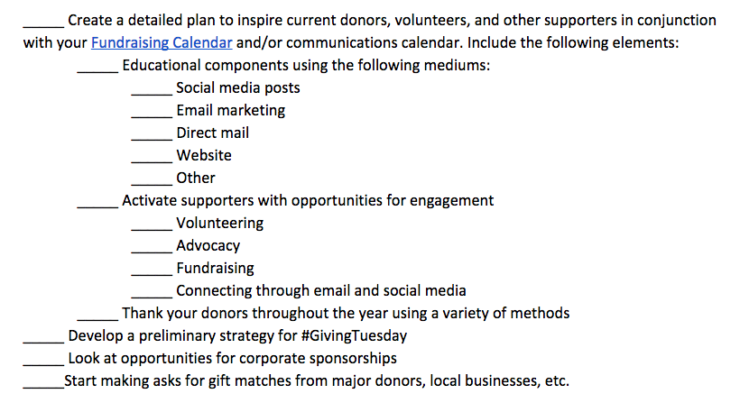I remember what it feels like to be a fundraiser once mid-January rolled around. There are thank you letters to write, data to input, reports to analyze, but there is also a sense of calm. After all, the fundraising “busy season” was now behind us. January always provided a great, but fleeting sense of peace. Because, before you know it, it’s time to get back at it.
Even though year-end fundraising is FINALLY behind you, don’t assume that means you should forget about it again until October rolls around. On the contrary, the 1st quarter of the year is a perfect time to start preparing for 2017’s year-end fundraising efforts. This is especially the case if you’re like the majority of nonprofits and charities that bring in around ⅓ of your annual gifts in December alone!
At CauseVox, we see hundreds and thousands of online fundraising campaigns annually. And year after year we find that most occur in the last 3-months of the year. While campaigns vary from one another in goal and scope, it’s obvious when one campaign stands out from the rest. 9 out of 10 times, the reason is preparation.
If you’re like one of the thousands of nonprofits and charities that brings in most of your individual donations from Thanksgiving to New Year, take this beginning of the year “down time” to plan, refine, and kickstart your year-end fundraising. You’ll thank yourself when November rolls around!
“Take this beginning of the year “down time” to plan, refine, and kickstart your year-end fundraising.” tweet this
Here’s how:
Create & Implement A Plan To Inspire Donors Throughout The Year
Without a doubt, you need to stay “connected” with your donors throughout the year. But you shouldn’t only focus on keeping your supporters peripherally connected with your cause. Think beyond basic touch points and instead focus on inspiring your donors and retaining them for years (not months) to come.
Vanessa Chase of The Storytelling Nonprofit agrees. “An effective donor retention strategy requires a plan and consistent action.” Therefore, you may need to take a big step back and create a detailed plan to ensure you plan your engagement and retention efforts right.
If you think about it, donor engagement and retention are essential job duties of any nonprofit fundraiser. And since you’ve already spent plenty of time creating a detailed fundraising calendar for the upcoming year, focus on incorporating cultivation strategies, including ways to educate, engage, and thank, directly into that planning document.
While not an exhaustive list, the following suggestions are bound to energize your donors and help grow your mutual relationship.
Educate
A great, effective way to inspire your year-end donors NOW is by educating them about why your cause is worth supporting. While it may seem like a “no-brainer”, it’s impossible to stress how important facts, figures, and stories are in sharing information about the influence your nonprofit or charity has on the world.
As you brainstorm ways to educate potential year-end donors, remember to keep messaging “donor centric.” This means you must keep reminding your audience that your progress is because of and dependent on their support.
“The less distance you put between your donor and your outcomes, the better you’ll be at fundraising.”
Keep donors updated on what’s going on in your organization using the following:
- Direct mail and email that feature stories and information that evoke emotion
- An updated, organized, and information-rich website
- Active social media accounts that feature shareable, relevant content
- Other
- Phone calls if you know a donor isn’t connected online
- In-person meetings if you have done this in the past
Activate & Engage
Engagement opportunities are a great way to pique your donor’s interest and keep them active and rallying for your cause from New Year’s Day to New Year’s Eve.
There are an unlimited number of engagement activities you can plan that will inspire and motivate your donors to take action so that when you’re ready to start asking for year-end gifts, your donors will be ready to open their wallets.
These are some of our favorites:
- Asking them to connect on social media
- Offering them a subscription to your eNewsletter or other emails
- Recruiting them to become volunteers. The Corporation for National and Community Service reports that volunteers are twice as likely to give as those who don’t volunteer, meaning that if a supporter volunteers they are more likely to give down the road.
- Advocating for your cause, such as by signing a petition
- Having them become a personal fundraiser like .impact’s Season’s Givings campaign. This activity doesn’t just activate your donors, it also has the potential to exponentially increase the number of people who know and support your cause. In fact, Guidestar found that almost ⅔ of donors give without doing any research, mostly because of recommendations from friends and family.

Thank
Thank donors after they’ve made a gift and throughout the year. Per Kivi Leroux Miller, “The best nonprofit thank yous feel friendly, warm, and personal.”
Keep this in mind as you craft your thank yous. Before you start sending out notes and making phone calls, sit back and create a strategy. Make a list of when you plan to send out a thank you and the medium you plan to use, including:
- Personal letter/email
- Phone call
- Donor appreciation event
- Personal visit
- Highlight/feature outstanding donors online or on your website
- List all donors in a publication such as your annual report
Here are a few best practices to help make your thank yous stand out:
- Avoid jargon and generic greetings at all costs
- Talk or write directly to your supporter
- Every thank you should be signed by a real person and not just your organization as a whole
By educating, inspiring, and thanking your donors throughout the year, you’re well on your way to a solid relationship and the potential for familiarity come year-end fundraising time.
Set The Groundwork To Leverage Year-End Gifts
Next, further prepare your year-end fundraising efforts by finding ways to leverage the individual year-end gifts. Focus on these areas:
Corporate Sponsorships
As you’re planning, take into account that many companies just began a fiscal year and some may have a pool of money to spend on philanthropic pursuits. As you may have experienced in years past, it’s actually quite difficult to secure business gifts and sponsorships as the holidays roll around. However, companies are more likely to give when their pockets are a bit fuller.
We suggest creating a list of 5 or more businesses you’d like to meet with. Then, do the following:
- Request a meeting or, at the very least mail a letter detailing your need. When the time comes, be upfront about what you’re looking for.
- Consider ways that businesses can “sponsor” events, such as a year-end donor appreciation dinner. A company may not be able to write you a big check but could provide an v in-kind donation.
- Remember to ask business leaders what you can provide for them. Offer options to collaborate in volunteer activities and other corporate-social engagement opportunities.
Gift Matches
When I was a fundraiser, we spent a whole lot of time keeping up with gift matches because they really helped our bottom line. Yet, it’s not just your organization that cares about bringing in every last cent—your donors do to.
Ally Dommu of Big Duck says “Everyone is looking to get more bang from their buck, even donors. So when you present a potential supporter with an opportunity to have their gift doubled or tripled, you make them feel like the impact of their gift is increased and it’s a worthwhile investment. How can someone that cares about your mission pass that up?”
Give your donors something to get excited about and bring in extra income at the same time by remembering to check on gift matches.
- Directly on your donation receipt, ask donors to check with their employer about a potential gift match.
- If you know your donor’s employer, do the work for them using a website like Matchinggifts.com
#GivingTuesday
In recent years, a large number of nonprofits and charities have begun to kickoff their year-end campaigns alongside #GivingTuesday. This “International Day of Giving” falls on the Tuesday following Thanksgiving. In this 24-hour period, organizations of every size, scope, and mission mobilize online supporters to raise money and awareness.
While it’s clearly too early to begin promoting #GivingTuesday, you can at least begin planning what your campaign will look like.
Consider:
- The online fundraising platform you plan to use, such as CauseVox or your website
- A campaign theme, especially if you can tie it into any other year-end campaigns you plan to run
- Goal
- Creating a marketing strategy and incorporate this into your annual communications calendar
In Summary
Whether your organization raises 10% of your budget at year-end or 60%, the time you spend focusing directly on fundraising efforts is bound to increase between October and December. Instead of running around in a daze, spend some time early in the year sowing the seeds for a fruitful year-end.
After creating a plan, begin implementing your activation strategies as early a possible. Inspire your donors through education, engagement, and sincere appreciation. At the same time, figure out how you’ll leverage donor gifts and increase the number of new and returning donors through extras like #GivingTuesday, corporate sponsorships, and gift matches.
Don’t let year-end fundraising sneak up on you. Start planning now—you’ll thank yourself later.
“Don’t let year-end fundraising sneak up on you. Start planning now—you’ll thank yourself later.” tweet this
Year-End Fundraising Checklist For Early 2017

For more information, check out these resources:
- Comprehensive Guide To Year-End Giving
- How To Plan A Successful #GivingTuesday Campaign
- The Donor Retention & Engagement Playbook
- Fundraising Planning Guide, Calendar Template & Goals Worksheet
What are you doing to start planning for year-end fundraising? Let us know below!




